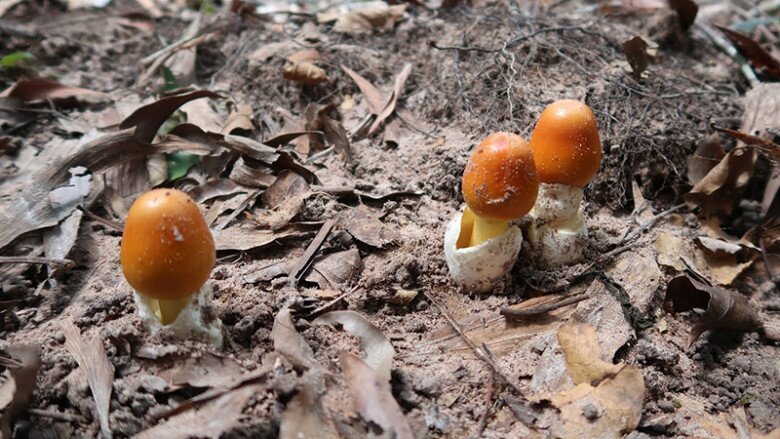The Caesar’s Mushroom, also known as Chicken of the Woods, was discovered in the 17th century. This fungus was favored by the Roman Emperor Caesar, leading to its naming by the mycologist Scopoli.
What sets Caesar’s Mushroom apart is its resemblance in size and appearance to a chicken egg, with a golden yellow color and a thin, white membrane surrounding it. The inside of the fungus resembles an egg yolk.
In Vietnam, this mushroom was once abundant in the northwestern mountainous regions. In recent years, it has been found in the forests of Binh Phuoc, Tay Ninh, Lam Dong, and Binh Thuan provinces.

Caesar’s Mushroom typically grows in deep forests and is most abundant from June to July each year. Photo for illustration.
Due to its growth in remote forests and relatively rare occurrence, with a peak season from June to July, along with its aromatic, delicious, and crispy texture, Caesar’s Mushroom is highly sought-after. It is sold at a price ranging from 350,000 to 500,000 VND per kilogram.
According to medical professionals, while Caesar’s Mushroom offers a unique flavor and is rich in nutrients, it also carries a risk of poisoning. Therefore, consumers should exercise caution when consuming this delicacy.
Health Benefits of Consuming Caesar’s Mushroom
As reported by The Health Site, similar to other types of mushrooms, Caesar’s Mushroom boasts an array of nutritional benefits:
Nutritional Supplement
Caesar’s Mushroom is a good source of various minerals, which can support and supplement essential nutrients for the body, thereby boosting immunity and enhancing overall health.
Weight Loss Aid
This fungus is low in calories and rich in fiber, making it a beneficial food for those aiming to lose weight. However, for effective weight loss, it is recommended to combine a balanced diet that includes this mushroom with regular exercise.
Source of Vitamin D
Caesar’s Mushroom is rich in Vitamin D, which optimizes the absorption of calcium, magnesium, and phosphorus, contributing to strong bones and teeth. Additionally, its antioxidant content, along with Vitamins A and C, promote eye health, boost immunity, and aid in collagen synthesis, thus slowing down skin aging.

Caesar’s Mushroom can be prepared in a variety of dishes that offer health benefits. Photo for illustration.
Digestive Health
The high fiber content in Caesar’s Mushroom helps regulate digestion and alleviates constipation.
Precautions When Consuming Caesar’s Mushroom
While mushrooms are nutrient-dense and packed with vitamins and minerals beneficial to health, they can also induce adverse effects in some consumers.
In Traditional Medicine, mushrooms are considered sweet and cool in nature, which clashes with foods that are extremely cooling, leading to diarrhea, stomach upset, or digestive issues. Examples of such incompatible foods include duck meat, snails, turnips, and seafood.
From the perspective of Eastern Medicine, the prolonged consumption of mushrooms can lead to cold stomach and indigestion. Individuals with weak digestive systems, frequent bloating, or slow digestion should refrain from eating mushrooms.
Additionally, it is crucial to purchase mushrooms from reputable sources and thoroughly prepare them before consumption to ensure food safety and eliminate harmful bacteria or microorganisms.
Ths.BS Nguyen Duc Long, Head of the Emergency Department at Phu Tho Obstetrics and Pediatrics Hospital, has treated patients suffering from mushroom poisoning. He advises that during the rainy season, when mushrooms grow rapidly, people often collect and cook them without distinguishing between edible and poisonous varieties, leading to food poisoning. Therefore, Dr. Long emphasizes the importance of identifying whether a mushroom is toxic or safe for consumption before ingesting it.

Medical professionals caution that Caesar’s Mushroom is a wild variety, and foragers must exercise caution. Photo for illustration.
According to Dr. Long, mushroom identification typically relies on color, smell, and shape. Poisonous mushrooms often exhibit bright colors, with white, black, or red spots on the cap. If a mushroom has a pleasant smell and exudes a milky substance when broken, it is likely toxic.
Additionally, mushrooms with bulbous bases resembling tubers are generally poisonous. However, in reality, some toxic mushrooms closely resemble edible varieties, making them challenging to distinguish. Therefore, Dr. Long advises foragers to gain adequate knowledge to identify different mushroom species and refrain from consuming mushrooms of uncertain origin.
If one experiences symptoms of mushroom poisoning, such as nausea, vomiting, or diarrhea, it is crucial to induce vomiting as soon as possible to expel the toxins from the body. Drinking plenty of fluids, preferably oral rehydration solutions (ORS), is also recommended. Subsequently, seek immediate medical attention at the nearest healthcare facility for proper treatment.




































